When it comes to choosing the place to grow outdoors, one of the most common questions among gardeners is: is it better to grow vegetables outside in the garden or to use a greenhouse?
Both outside and greenhouse gardening have their own unique advantages and challenges. Choosing the best option for you will depend on the types of vegetables you want to grow, your local climate, the space you have available, and your personal preferences.
Let’s take a deep dive into the advantages and disadvantages of each method to help you find the best fit for your green thumb.
Quick Navigation
- Pros and Cons of Growing Vegetables Outside
- Pros and Cons of Growing Vegetables in a Greenhouse
- Factors to Consider When Choosing to Grow Your Vegetables In a Greenhouse or Outside
- Planting the Seed of Decision
Pros and Cons of Growing Vegetables Outside
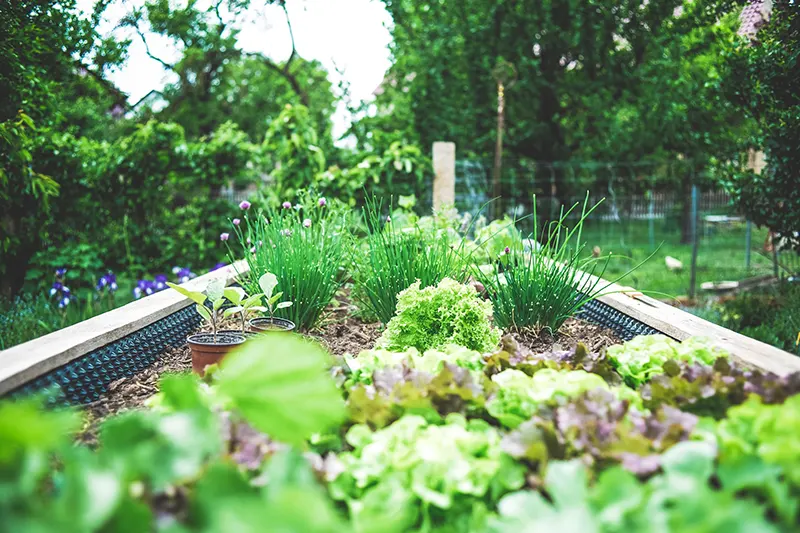
Growing vegetables outside, in a traditional garden, is the way our grandparents did it, and their grandparents before them. It’s a time-tested method with both its charm and challenges.
Pros of Outdoor Gardening
Natural Environment
There’s a certain charm to growing outdoors that revolves around harnessing the power of nature. It uses natural sunlight, which is an abundant source of energy and provides the complete source of light that plants need.
Plus, natural rainfall contributes to watering your plants, reducing the need for manual watering or irrigation systems.
Lastly, outdoor gardens attract a host of pollinators – from bees to butterflies and birds – which can enhance plant pollination and increase your crop yield.
Space
If you’re lucky enough to have a spacious backyard, outdoor gardening provides the opportunity for you to grow a vegetable garden of your choice.
The flexibility of large spaces means you can experiment with crop rotation, planting different types of vegetables in different seasons.
This not only maintains the soil’s health by preventing the build-up of pests and diseases, but it also improves soil fertility as different outdoor crops deposit varying nutrients into the soil.
Cost
In terms of financial investment, outdoor gardening typically has a lower entry barrier. You avoid the initial expenses associated with constructing a greenhouse, and ongoing maintenance costs are also generally reduced.
Apart from purchasing seeds, fertilizers, and perhaps a few gardening tools, you can start an outdoor garden with relatively little outlay.
Cons of Outdoor Gardening
Weather Dependence
Perhaps the most challenging aspect of outdoor gardening is its reliance on weather patterns. Plants are at the mercy of mother nature, and unexpected weather fluctuations can wreak havoc on your garden.
Early frosts may kill off tender plants, extreme heat can cause other plants to wilt, heavy rain might lead to waterlogged soils, and warmer months can leave plants parched.
These unpredictable conditions require the gardener to be vigilant and adaptive to protect their plants.
Pests and Diseases
Another possible problem with outdoor gardening is that it makes the vegetables you’ve grown more prone to pests, diseases, and the use of toxic pesticides.
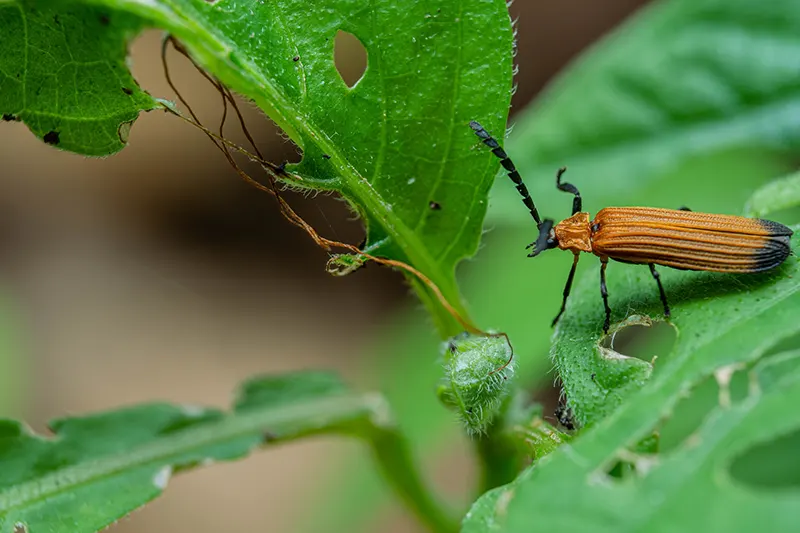
Without the protective barrier of a greenhouse, plants get exposed to pests like aphids, caterpillars, and slugs, as well as diseases such as blight or powdery mildew.
It’s essential to monitor your garden closely for any signs of these problems and act promptly to minimize damage.
Pros and Cons of Growing Vegetables in a Greenhouse
Knowing the upsides and downsides of greenhouse gardening is essential for making the right choice.
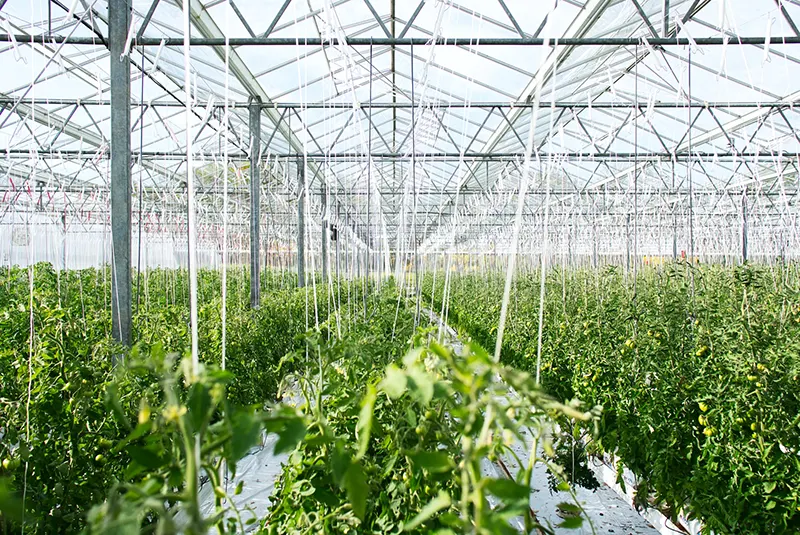
Let’s take a closer look at the various pros and potential hurdles you might face when growing greenhouse vegetables.
Pros of Greenhouse Gardening
Controlled Conditions
One of the most significant advantages of greenhouse gardening is that it gives you the ability to control the conditions your plants are exposed to.
1. Temperature Control
Greenhouses are essentially insulated boxes that trap heat. This unique characteristic allows you to maintain a consistent temperature, ensuring your plants are never too cold or too hot. This consistent climate can lead to healthier plants and potentially higher yields.
For example, heat-loving plants like tomatoes and peppers can love the warm temperatures of a greenhouse environment and hate the cooler temperatures when grown outdoors. This gives you the power to grow year round and avoid seasonal dependence.
2. Humidity Control
A greenhouse allows you to regulate humidity levels, which is very beneficial for plants that like a more humid environment. Certain plants thrive in damp conditions, and managing humidity can make all the difference in their growth.
Conversely, if you’re growing plants that require drier conditions, you can use ventilation and heating to reduce humidity as needed.
Having the flexibility to control this key factor can result in healthier, happier plants and can significantly improve your harvest.
This capacity to manipulate humidity levels, depending on the specific needs of your plants, provides a distinct advantage over outdoor gardening, where you’re often at the mercy of the local climate.
3. Extended Harvest into Colder Months
Similarly, as the chill of fall and winter starts to creep in, the greenhouse remains a sanctuary for your plants. With its ability to trap and retain heat, your greenhouse can extend the productivity of your plants well into the colder months.
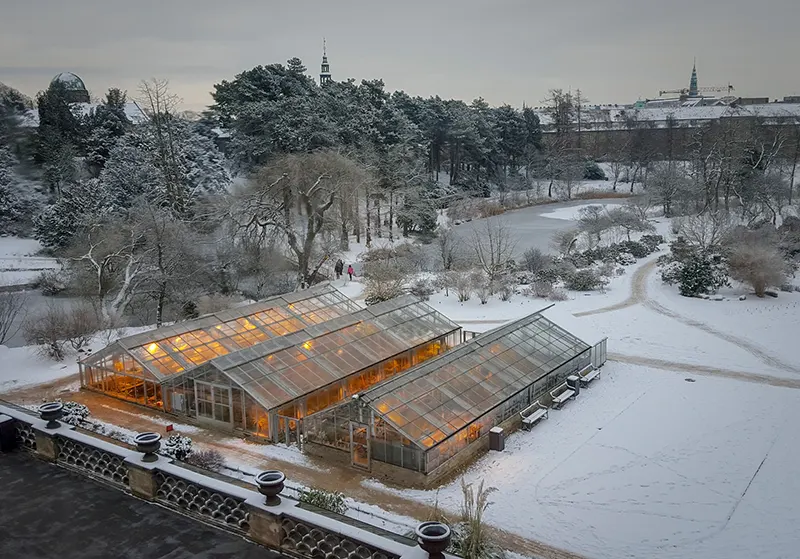
This extension gives you a longer harvest period and the possibility of fresh produce year-round, something an outdoor garden typically can’t provide.
Whether it’s crisp lettuce in November or juicy tomatoes in early spring, your greenhouse can turn these dreams into a reality.
Protection from Pests and Weather
Greenhouses also provide a robust barrier against many of the common challenges faced by outdoor home gardeners.
1. Pest Protection
Many pests that wreak havoc on outdoor gardens and kill tender plants find it much more challenging to invade a greenhouse. By nature of its design, a greenhouse can keep out critters like rabbits and deer.
It can also make it harder for smaller pests like aphids and beetles to reach your plants. And since you have greater control of the introduction of new plants into the space, you can ensure they are pest-free before they enter, reducing the risk of infestations.
2. Weather Protection
Outside, plants are at the mercy of the elements. Wind, rain, hail, and extreme temperatures can all damage or even destroy your hard work.
A greenhouse, on the other hand, offers a protective shield. It can stand up to heavy winds, prevent battering by heavy rains, and shield your plants from the scorching sun.
It ensures that no matter what’s happening outside, your plants remain safe and secure in their controlled growing environment.
Cons of Greenhouse Gardening
Cost
The initial setup cost for a greenhouse can be high, especially if you’re considering a large or high-quality structure. The final cost will depend on the size, materials, and features of your greenhouses.
On average, it typically ranges from a few hundred to several thousand dollars.
In addition, maintaining the right conditions inside the greenhouse, such as heating, cooling, and ventilation systems, can add to ongoing costs.
You may also need to invest in grow lights, irrigation systems, and other equipment to optimize your greenhouse’s performance.
Management
Growing root vegetables, cool weather vegetables, and warm season crops each require different levels of care.
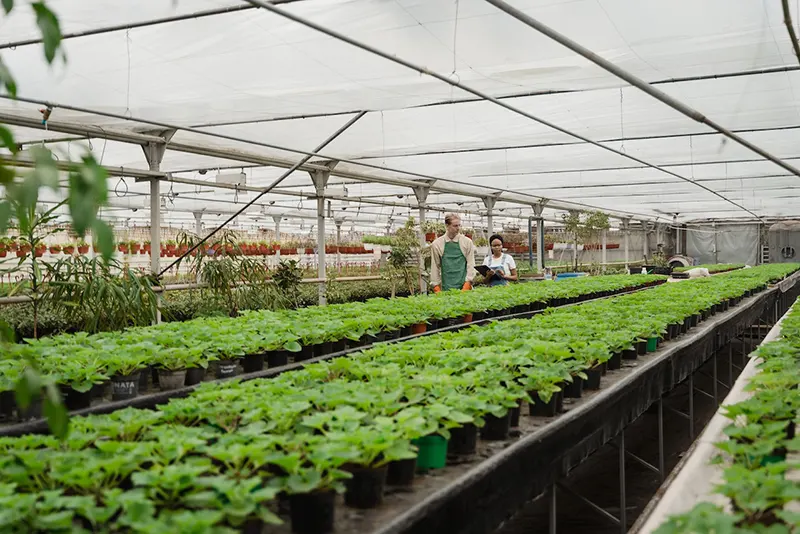
Thus, managing a greenhouse’s environment requires a greenhouse gardener to have more knowledge and attention compared to outdoor gardening.
It’s important that you consistently monitor and adjust temperature, humidity, and light levels to make sure that your plants grow in the best conditions.
This can be time-consuming and may require a steep learning curve if you’re new to greenhouse gardening.
You’ll also need to stay vigilant about potential issues such as pests and diseases since a controlled environment can sometimes make it easier for these problems to spread if not addressed promptly.
Space Requirements
If you want to have a greenhouse, you will need to dedicate an area in your property to properly set it up.
You’ll also need to consider other factors such as access to sunlight, how much space you have available, and zoning restrictions when choosing the location.
In smaller yards or urban settings, finding an appropriate spot for a greenhouse might be challenging.
Energy Consumption
Greenhouses can consume a significant amount of energy, particularly in colder climates where heating systems are necessary to maintain optimal growing conditions.
This means you will likely have to pay more for electricity and increase your carbon footprint. It’s essential to consider energy-efficient options, such as proper insulation and alternative heating methods, to minimize the environmental impact and ongoing costs.
Limited Interaction with Nature
One of the best parts of outdoor gardening is the direct connection with nature, the fresh air, and the opportunity to observe local wildlife.
Greenhouse gardening can feel more isolated and artificial, as you’re separated from the outdoor environment by the greenhouse structure.
Some gardeners may find this aspect less enjoyable than working directly in an open garden setting.
Factors to Consider When Choosing to Grow Your Vegetables In a Greenhouse or Outside
Now that we’ve discussed the pros and cons of both greenhouse and outdoor gardening, it’s time to take a look at the specific factors that can help guide your decision.
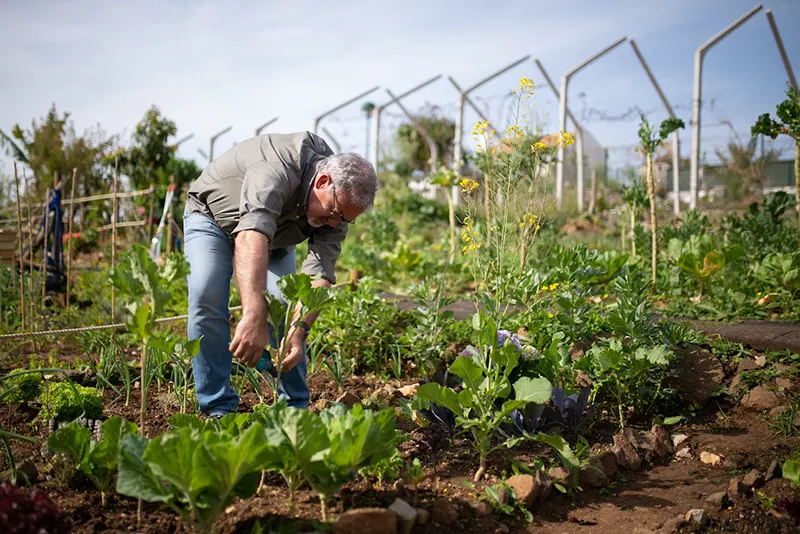
These considerations are tailored to your unique circumstances and goals, ensuring you make the right choice for your gardening journey. Let’s break down these factors:
Your Climate
The climate in your area plays a significant role in determining whether outdoor gardening or greenhouse gardening will be more successful. Each plant has its preferred growing season.
If you live in an area with extreme weather conditions—be it sweltering heat, harsh winters, heavy rainfall, or high winds—a greenhouse is better for you because it can provide a controlled environment that offers your plants protection and consistency.
On the other hand, if your region has a temperate climate with plenty of rainfall and sunshine, outdoor gardening could be a more natural and cost-effective option.
Available Space
The space you have available is another important factor. If you have a large backyard, you might have enough room to set up a greenhouse while also maintaining an outdoor garden.
However, if you have a small space, you can go with a smaller greenhouse or just choose to have an outdoor garden. You can even start a container garden.
A small greenhouse can fit into surprisingly tight spaces and allows for vertical gardening, which can maximize your yield per square foot.
Conversely, an outdoor garden can be as big or as small as you like, fitting into any available nooks and crannies in your outdoor space.
Type of Vegetables
Different vegetables have different preferences when it comes to growing conditions. Some plants, like tomatoes, peppers, and cucumbers, thrive in warmer temperatures and stable conditions that a greenhouse provides.
However, other vegetables, such as carrots, radishes, and most leafy greens, are hardy and can do well outdoors, even in cooler weather.
It’s essential to research the needs of the vegetables you plan to grow and match them to your gardening setup.
Resources
Gardening, whether in a greenhouse or outdoors, requires an investment of resources.
You’ll need to consider your budget—bearing in mind that while a greenhouse can be a more significant initial investment, it can also lead to higher yields and year-round growth potential.
Time is another resource to consider. Maintaining a greenhouse requires regular monitoring and adjustment of conditions, while outdoor gardening often needs more weeding and can be more physically demanding.
Finally, consider your knowledge and willingness to learn new techniques. Greenhouse gardening may have a steeper learning curve but can also offer a fascinating deep dive into the science of plant growth.
Planting the Seed of Decision
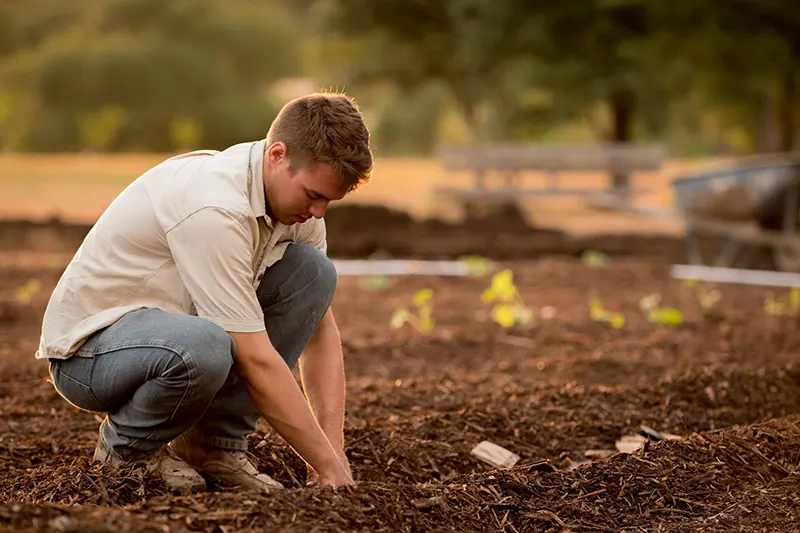
As we come to the end of our gardening exploration, it’s clear that both outdoor and greenhouse gardening have unique advantages and challenges.
Your decision between the two should align with your individual circumstances, gardening goals, and personal preferences. The best vegetables to grow are the ones well suited for the environment you can provide.
Whether you’re drawn towards the natural rhythm and spaciousness of outdoor gardening, or the controlled, year-round productivity of a greenhouse, remember that both paths can yield a bountiful harvest with the right approach and dedication.
